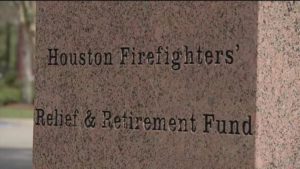 Houston’s three public pensions may not be in total distress today, but some of the instrument panels are beginning to flash orange.
Houston’s three public pensions may not be in total distress today, but some of the instrument panels are beginning to flash orange.
One of the warning signs is the hit to the city’s credit-ratings earlier this year, as
Moody’s Investors Service downgraded the City of Houston’s debt on March 16 2016.
You might guess that the main problem with the City of Houston’s credit rating is the slowdown in the oil services business, and that’s certainly a short-term issue.
But Moody’s specifically cited large unfunded pension liabilities as one of the four main reasons to downgrade city debt to Aa3 and keep it on “negative outlook,” calling the liabilities “among the highest in the nation.” Lacking a plan to address the pensions, Moodys wrote in March, could lead to a further downgrade in the city’s bond rating.
 Let’s review some statistics on the pensions for firefighters (acronym: HFRRF), police officers (acronym: HPOPS), and municipal employees (acronym: HMEPS).
Let’s review some statistics on the pensions for firefighters (acronym: HFRRF), police officers (acronym: HPOPS), and municipal employees (acronym: HMEPS).
Things to monitor
Remember, the first two things to monitor, with respect to the health of a pension plan, are the funded ratio – roughly how much of future payments are already covered by investments – and years to amortization, otherwise known as the time needed to pay down debts. I’ve previously said that an 80 percent funded ratio is considered ok, although closer to 100 percent would be preferred. For years to amortization, a 15 to 20 year time frame seems manageable, while 40 years to infinity invites state monitoring and restrictions.
So what do we worry about the Houston plans in particular when we see the funded ratio and the years to amortization?
Here are the two measurables on the three Houston pension plans:
HFRRF – 86.6 percent funded ratio, 30 years amortization
HMEPS – 54 percent funded ratio, 32 years amortization
HPOPS – 79.8 percent funded ratio, 23 years amortization
Honestly, using just those measurements, only the HMEPS funded ratio makes me worried. If you’re not frightened by the first two measurements of funded ratio and amortization – and when I look at them I don’t personally get panicked – the next thing to monitor gets trickier.
You see, the firefighters’ and municipal workers’ plans assume an 8.5% annual return on investments, while the police plan assumes an 8% return. Not only do all three assumptions seem too high, but the first two plans are complete outliers. In a survey done by the National Association of State Retirement Administrators in early 2016, only 1 out of 127 plans assumed an 8.5% return. So, Houston firefighters and muni workers have an aggressive – actually my preferred word would be unrealistic – set of assumptions.
Last Fall, the Chairman of the HFRRF Todd Clark defended their outlier return assumptions in the Wall Street Journal, saying “We strongly believe, and past history shows, we can continue to achieve the 8.5% long term.” Clark resigned in July. HFRRF Executive Director Ralph Marsh declined to comment on my questions about the assumed return, or others posed about their pension fund.
 The last 20 years’ average pension returns were 7.47 percent, according to the Wall Street Journal.
The last 20 years’ average pension returns were 7.47 percent, according to the Wall Street Journal.
As a finance guy, I wish I could intuitively explain to the non-finance reader the uncomfortable tingly feeling in my toes that I get about that math. The effects of being wrong by just 1 percent, compounded over decades in a pension plan, are huge. We can see some of the scary implications from a presentation done by the Houston plans for the Texas legislature in June.
In that presentation, they showed that if you shift the return assumptions on Houston’s police and municipal employees down by 1 percent, suddenly the police pension plan only has a 54.6 percent funded ratio, while the municipal employees plan goes to a 49 percent funded ratio. So, like, only half the money needed to pay out retirees is currently available in the plans. Ugh. The instrument control panel not only shows blinking green lights turning into red lights, but sparks are starting to shoot out of the dials. Danger Will Robinson!
Now you start to get a sense for why Moodys downgraded the City of Houston in March, and why the Chairman of the Pension Review Board is trying to sound the alarm on Houston pensions.
City Budget Constraints
You see, the next big problem is that fixing pension shortfalls begin to eat into city budgets, a process already underway in Houston.
Josh McGee, who serves as both the Vice President of the Laura and John Arnold Foundation – a Houston think-tank focused on public finance, as well as the Chairman of the Texas Pension Review Board – points to a worrisome trend for Houston’s city budget.
 In 2001, required pension contributions made up just 6.7 percent of general fund revenue, or the amount of money in the city budget not otherwise allocated to specific purposes. By 2015, the required pension contributions have climbed to 19.2 percent of the general fund. The trend here, tracked by McGee, has been steadily upward.
In 2001, required pension contributions made up just 6.7 percent of general fund revenue, or the amount of money in the city budget not otherwise allocated to specific purposes. By 2015, the required pension contributions have climbed to 19.2 percent of the general fund. The trend here, tracked by McGee, has been steadily upward.
McGee compares Houston’s situation today with Chicago’s situation a decade ago. In Chicago, the comparable pension payment to the general fund rose from 19 percent to a stunning, and devastating, 54 percent today.
That means city leaders can’t decide to pay for stuff in a city without dedicating half their discretionary budget to fill in holes in pension plans – money already owed to workers, for work already performed. You have to rob Peter to pay Paul. Chicago is in a terrible bind today, and McGee openly worries Houston will follow down that path without a course correction.
So what happens if these plans stay in trouble? Realistically, political leaders don’t just say “Whoops” and send a shrugging emoji to pensioners. They especially don’t do this with politically sensitive pensioners like police, fire and city employees.
No. Instead, they fund the plan, and then taxes go up. Or they fund the plan, and other discretionary city services go way down.
The only other fix is to significantly reduce benefits for future employees.
Either way, residents previously blissfully unaware of such boring actuarial minutia as funded ratios, amortization schedules and actuarial unfunded liabilities unhappily begin to care, deeply and late, about such problems.
A version of this post ran in the San Antonio Express-News and the Houston Chronicle.
Please see related posts
The Dallas Police and Fire Pension Mess
Post read (281) times.




